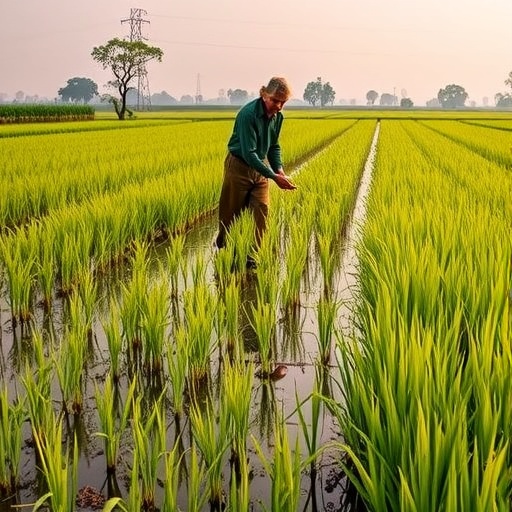In the ever-evolving landscape of climate science, the significance of mitigating methane emissions from agriculture, particularly rice cultivation, is receiving increasing attention. Methane, a potent greenhouse gas, contributes significantly to global warming, with rice paddies identified as one of the substantial sources of this gas. Researchers and environmentalists are focusing on innovative strategies to reduce methane emissions, which result from anaerobic decomposition occurring in flooded rice fields. As rice serves as a staple food for more than half of the world’s population, the dual challenge of sustaining food security while combating climate change is profoundly compelling.
Historically, rice cultivation has been associated with high methane emissions, primarily due to waterlogged conditions that facilitate anaerobic digestion. Various studies have outlined how the decomposition of organic matter under such conditions produces methane, leading to heightened global warming potential. The article sheds light on historical approaches that aimed to address these emissions, revealing the gradual evolution of understanding and methodology towards achieving sustainable rice production.
One of the game-changing advancements discussed is the integration of alternate wetting and drying (AWD) techniques in rice farming. This agronomic method involves allowing fields to dry intermittently, as opposed to maintaining continuous flooding. Research indicates that AWD can reduce methane emissions by as much as 50%, providing a win-win solution that not only lessens environmental impact but also enhances water use efficiency. Several countries, especially in Asia, have successfully implemented AWD, showcasing its potential as a mainstream practice that can lead to substantial reductions in greenhouse gas emissions.
Additionally, the role of land management practices comes into play, with researchers emphasizing the importance of soil health in mitigating methane emissions. Healthy soils, teeming with microbial life, are better equipped to manage organic matter decomposition, resulting in lower methane production. Strategies such as incorporating organic amendments and cover cropping can enhance microbial diversity and activity in soils, thereby playing a crucial role in methane mitigation. The significance of these practices extends beyond just emissions reduction, as they also contribute to improved soil fertility and crop resilience.
Another innovative avenue explored in the article involves the genetic modification of rice plants. Advances in biotechnology have enabled scientists to develop rice varieties that either emit less methane or are more efficient in nutrient uptake, thus reducing the organic matter that contributes to methane generation. The promise of genetically engineered rice strains represents a forward-thinking approach to addressing emissions at the source, offering a potential long-term solution to a pressing global challenge.
In addition to agricultural practices and genetic advancements, the importance of policy frameworks and farmer engagement is highlighted. Effective policies that incentivize sustainable practices, coupled with education and support for farmers, are essential for fostering a cultural shift towards emission-reducing techniques in rice cultivation. The article discusses various case studies where government interventions and stakeholder collaborations have successfully led to reductions in methane emissions, underlining the multifaceted approach required for meaningful change.
The future of methane mitigation in rice production is also closely tied to technological innovation. Precision agriculture and digital farming technologies are emerging as powerful tools for monitoring and managing rice fields. Sensors and satellite imaging can provide real-time data on moisture levels, crop health, and emissions, allowing farmers to make informed decisions that reduce their environmental footprint. This synergy of technology and agriculture offers a glimpse into the future of sustainable rice farming, where efficiency and environmental stewardship coexist.
As the global community confronts the escalating challenges posed by climate change, the methods identified in the article provide a roadmap for the future of rice cultivation. The ongoing discourse around methane emissions serves as a call to action for researchers, policymakers, and farmers alike. By embracing interdisciplinary approaches that combine agronomy, genetics, and technology, a sustainable path forward can be charted that ensures food security while mitigating the adverse effects of climate change.
The article emphasizes the urgent need for collaborative efforts in research, policy, and on-the-ground farming practices. Comprehensive strategies that consider the social and economic dimensions of rice farming will be pivotal in driving meaningful reductions in methane emissions. As the world looks towards a sustainable agricultural future, the insights gleaned from this research underscore the importance of proactive measures that can significantly decrease methane output from rice cultivation.
In conclusion, the multi-faceted strategies presented in recent research illuminate a pathway towards optimal methane management in rice farming. Addressing the complexities of emissions requires an integrated approach that marries traditional practices with cutting-edge science and technology. The commitment to developing and adopting these strategies could redefine rice cultivation, transforming it into a more sustainable practice that aligns with global climate goals.
The ongoing dialogues in scientific communities and agricultural sectors are not just about mitigating emissions but also about reimagining our relationship with land and resources. Only through collective action can we ensure that rice cultivation not only supports a burgeoning global population but also remains a sustainable and environmentally-friendly practice.
In light of the crucial findings highlighted in this research, it is clear that as we move forward, a unified approach that combines cutting-edge science with grassroots activism will be imperative. The ambition to cultivate rice without exacerbating the climate crisis is not just necessary; it is a testament to humanity’s resilience and ingenuity in the face of global challenges.
By adopting these strategies, we can empower farmers, protect our planet, and promote food security—ultimately paving the way for sustainable agriculture that benefits both people and the environment alike.
Subject of Research: Methane emissions mitigation in rice cultivation
Article Title: Advances in mitigating methane emissions from rice cultivation: past, present, and future strategies.
Article References:
Xuan, T.D., Minh, T.T.N., Rayee, R. et al. Advances in mitigating methane emissions from rice cultivation: past, present, and future strategies.
Environ Sci Pollut Res (2025). https://doi.org/10.1007/s11356-025-36776-8
Image Credits: AI Generated
DOI: 10.1007/s11356-025-36776-8
Keywords: methane emissions, rice cultivation, climate change, sustainable agriculture, alternate wetting and drying, biotechnology, land management, precision agriculture.




